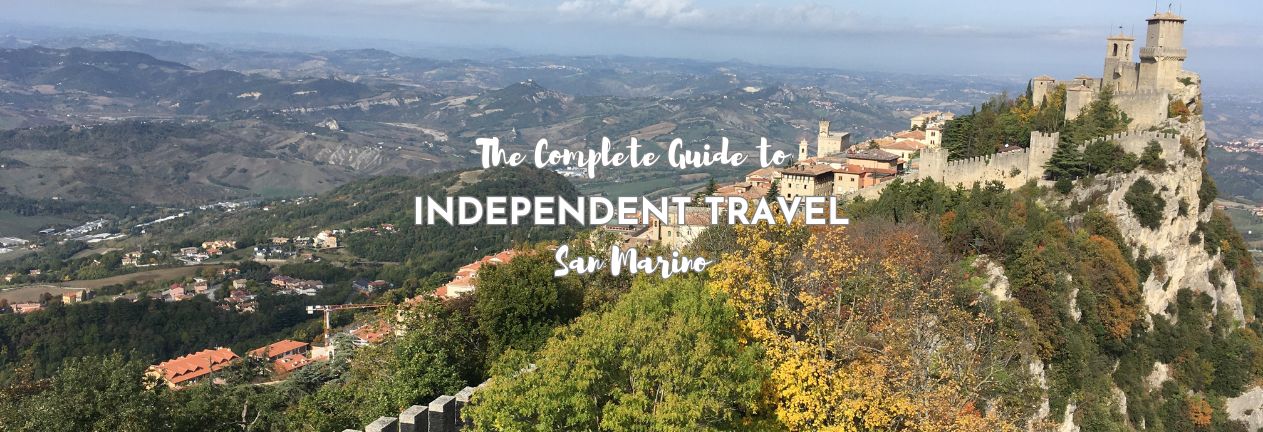It’s the fifth smallest country in the world. It’s completely landlocked (by Italy). It has its own government and laws, and it’s also the world’s oldest sovereign state. This is San Marino. It was likely the first country to establish a postal service, and Abraham Lincoln was made an honorary citizen. It is not a member of the EU or the Eurozone, but it uses the Euro. And honestly, it’s capital, high on top of Monte Titano, with its medieval towers and fortress walls, it looks straight out of Lord of the Rings or Harry Potter. It’s really easy to visit San Marino, and this is my guide to independent travel to San Marino.
THIS POST MAY CONTAIN COMPENSATED AND AFFILIATE LINKS MORE INFORMATION IN OUR DISCLAIMER
I’ll cover the practicalities of visiting San Marino: how to get here, where to stay, and how much you’ll spend. I’ll go through the highlights of what to see, from the famous Three Towers to fabulous walking trails, as well as the best time to visit, how to get around, and the local food and drink you shouldn’t miss.
We spent a couple of days here, but it’s easy to visit on a day trip – and if you’re looking for more detail on how to see San Marino in a short space of time, then don’t miss my San Marino in One Day guide.
PRACTICAL TRAVEL TIPS
- 🛡️ Get Travel Insurance: Civitatis includes medical expenses, repatriation, theft, luggage delays. No deductibles or upfront payments. Get a quote here.
- 🛏️ Sea view? Laundry? Private bath? Book a Room.
- 🔌 Be ready for the plug, socket & power situation.
- 📶 Internet, maps and data on the go. eSims for Travel
Why Visit San Marino as an Independent Traveler?
I suppose this actually should be “why not?”. It’s easy to visit independently, and San Marino is small enough to visit without getting lost. However, the enormous history of this place might keep you here longer than you anticipated.
A day trip is a good way to see the country; it’s easy to visit by taking the cable car up from Borgo Maggiore, walking the ridge to all three towers, picking out a museum or two, and then having an early dinner. But if you stay overnight, you’ll see another side to the country. The capital empties, and it’s incredibly atmospheric. My guide on what to see and do in San Marino is here.
How to get to San Marino
You can easily visit San Marino on a day trip from Florence, Bologna, or Rimini. There are details here. Alternatively, if you’re driving, it’s a simple matter; you’ll just need to choose where you park your car. The routes off the A14 from Bologna to Ancona are well signposted.
Public transport users can take the train to Rimini, and then a bus from Rimini to San Marino.
There’s more in my guide on how to get to San Marino here.
Essentials & Planning for San Marino
San Marino is small, but you’ll have a better time here if you do a little planning. Logistics for here are simple, though, so this won’t be difficult.
Visas & Entry to San Marino:
There are no border controls or visas needed as you’re entering via Italy (there’s no other way, unless, I guess, you have a helicopter!). The tourist office will stamp your passport if you wish, but it seems a shame to take up space. Some governments also do not like you getting “novelty” stamps in your passport.
The Language of San Marino:
The official language in San Marino is Italian, but Romagnol, which is the old dialect of the surrounding Emilia-Romagna region, is also spoken. You’ll get by in English at most of the tourism sites.
How Long to Stay in San Marino:
A day trip will get you around the highlights, but an overnight stay is a delight. We loved wandering the cobbled streets, having an Aperol before dinner, and sauntering back to our hotel in the quiet.
Money & Payments in San Marino:
San Marino uses the Euro. Just take your card, they’re accepted everywhere.
Where to stay in San Marino
It’s most convenient to stay inside or just outside the historic center at the top. For short stays, I’d suggest staying in the historic center to be close to the things you want to see, do, and eat. Budget options are down at the bottom of the cable car at Borgo Maggiore, but then you’ll need to either walk up or take the cable car. If you want to explore the farm stays, aka agriturismi, then that’s possible too. San Marino isn’t just about Monte Titano!
We stayed at the Hotel Joli. It’s right next to the historic center, and we parked within 20 meters of the hotel. There are great views over the surrounding countryside or of the historic center. We opted for an included breakfast, but they also offer dinner.
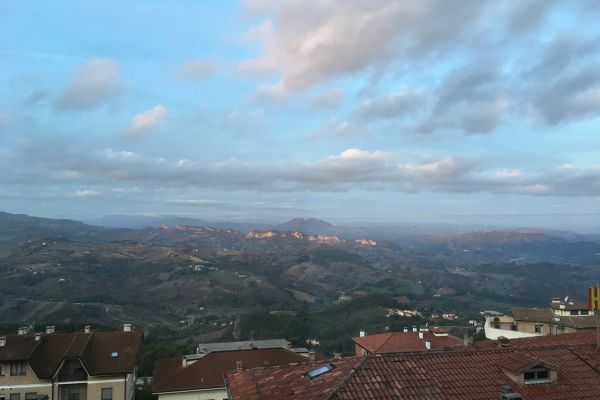
If you prefer to stay inside the historic center, opt for the Hotel Rocca; there are amazing views and a superb staff here.
When to Visit San Marino
The weather is best in San Marino between May and September. The weather is generally temperate, although it can be very hot in high summer (July and August). You’ll find it very cold between November and February, and temperatures will often drop below freezing. Winter is not only cold, but you’ll see more chances of rain, which often doesn’t appear at all in the summer months. And yes, you might see snow during the winter months, too! Winter time is the cheapest time to visit San Marino, aside from Christmas, when, of course, you’ll enjoy the festive spirit of the country, but prices are likely to rise. Autumn is a great time to visit for food and wine festivals, as well as the anniversary of the foundation of the republic on September 3rd each year.
We visited in the third week of October and enjoyed bright sunny days, quite crisp temperatures at night, but needed nothing more than a fleece in the evening.
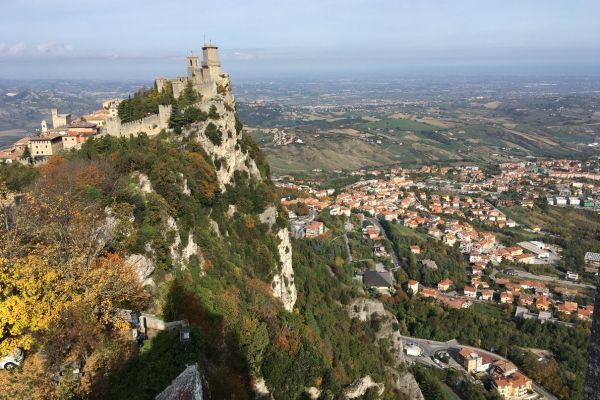
How big is San Marino?
San Marino covers just 61 square kilometers (about 24 square miles) and has about 34,000 full-time residents living across its nine towns, which are known as castelli. Most people visit only one of these castelli, the city and capital of San Marino, which is also called San Marino.
Transport & Practicalities in San Marino
Getting around San Marino is really easy. You’ll want to use a mix of transport to see the best of the country. For more details on how to get to San Marino, my guide is here
Without a Car: Take a bus from Rimini to Borgo Maggiore (essentially the bottom of the hill!), then a two-minute cable car up to the historic center.
Driving: Roads are good and signs are clear. The historic center has small roads, and you’ll need to use the hillside car parks to access the old town. You can’t drive into the old town itself.
Cable Car & Walking: The cable car runs every 15 minutes. Once you’re up in the historic center, everything is walkable, but not particularly level, so bring decent walking shoes.
Public Transport: There’s a local bus network and the cable car, the Funivia di San Marino. The buses are very limited, despite there being 8 bus lines. You can see the map of the transport routes here.
How long do you need in San Marino?
You can easily visit San Marino in a day, and many visit San Marino on a day trip from Rimini, Florence, and Bologna. A day will give you plenty of time to explore the historic center fully. If you want to visit any of the other castellis, then add another day. It’s a delight to spend the evening in San Marino, after the day visitors have disappeared.
History & Facts about San Marino
301 A.D. Founded in 301 A.D. San Marino was originally a refuge for Christians fleeing the Roman Emperor. The stonemason, Marinus, made his base on the top of Monte Titano, and the area was named after him. Despite being invaded twice, it retained its independence until 1291, when it was formally declared an independent state by Pope Nicholas IV.
Until 1463, San Marino was just the area of Monte Titano, but on the successful defeat of Sigismondo Pandolfo Malatesta, Lord of Rimini, Pope Pius II ceded the towns of Fiorentino, Montegiardino, and Serravalle in return for the support given in overthrowing Malatesta. Faetano, another nearby town, also joined the republic in that year.
San Marino has been invaded twice, but on both occasions, for just a short period of time. First, in 1502, Cesare Borgia occupied San Marino until his father, Pope Alexander VI, died. Then, in 1739, Cardinal Alberno sent the military in to occupy San Marino in an attempt to gain more political power. It didn’t work.
1600: The San Marino constitution was drafted in Latin. The Statutes of 1600 consist of six books. It seems to be an academic argument as to whether multiple texts can be counted as a constitution, so some say that the US Constitution is the oldest in the world still in effect.
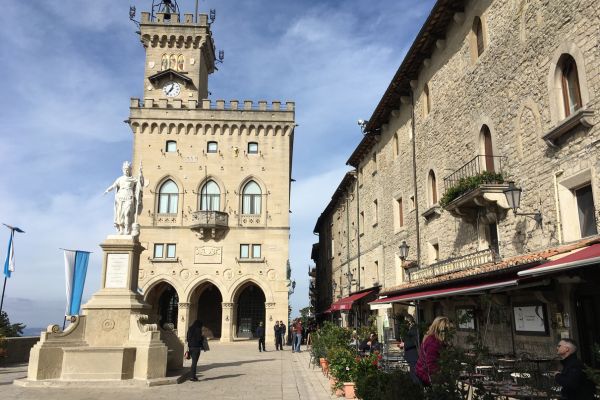
1607: A postal service was introduced, likely the first country in the world to do this. It wasn’t until 1877 that postage stamps were issued, however.
In 1849, Giuseppe Garibaldi sought sanctuary within the San Marino fortress; he later assisted San Marino from being included in the 1867 Italian unification.
1861: Abraham Lincoln, Former US President, wrote to the Captain’s Regent saying “, ‘Although your dominion is small, nevertheless your State is one of the most honored throughout history”. He was granted honorary citizenship.
1862 saw an official treaty of friendship with Italy that has been in place ever since.
1939-1945 San Marino remained neutral during World War II, but gave asylum to 100,000 refugees from the surrounding Italian area.
Summer 1960: San Marino enters its first Olympic Games.
1983: Established official relations as a Third State with the European Union.
Things to Do in San Marino
You shouldn’t miss the three towers, Guaita, Cesta, and Montale, which are linked by a rather lovely walk. Liberty Square is also a great place for people watching. If you’re looking for museums, then the State Museum is worth a look, but the Emigrant Museum and the Titanus Museum offer something a little different, too.
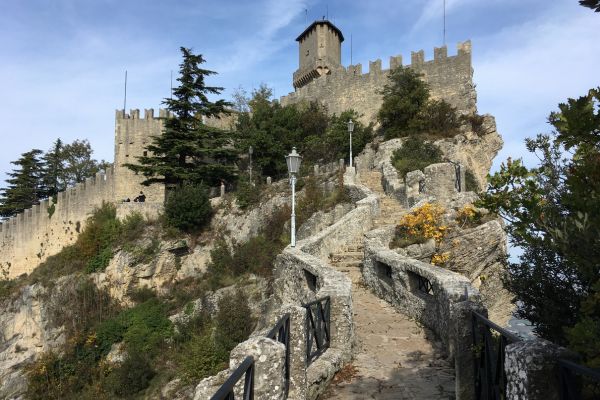
To learn more about the state, a guided walking tour with a local is the best option, but San Marino is also a fabulous place to wander and discover on your own. My guide to the best things to do in San Marino is here.
What to Eat in San Marino
Despite being enclosed within Italy, San Marino has some specialties of its own when it comes to food and drink. And while there are undoubted influences from the neighboring region of Emilia Romagna, here’s my guide on what you should eat in San Marino.
SANMARINO TRAVEL RESOURCES
TAXI & TRANSFERS
24/7 pickup & drop off. Trusted, local English speaking drivers. Prebook & prepay online with cards.
Book a Transfer
HOTELS AND APARTMENTS
See choices here
Rooms with a view? Budget rooms? Need a washing machine? The best choice of hotels & apartments.
TOURS & ATTRACTIONS
Most excursion choices, small group tours, skip-line tickets, free cancellation and top local guides.
Top options here.
CAR RENTAL OPTIONS
Choose cars here
Best choice of vehicles, automatics, large or small cars, child seats. Book early for more options.
Final Words on Independent Travel in San Marino
San Marino may be small, but it’s memorable. The views from the three towers are spectacular, eating dinner in the streets after all the day trippers have gone home is fabulous, as is exploring the cobbled streets, museums, and understanding the history of this really rather unique place.
ASocialNomad is a participant in the Amazon Services LLC Associates Program, an affiliate advertising program designed to provide a means for sites to earn advertising fees by advertising and linking to amazon.com, amazon.co.uk, and amazon.ca. Amazon and the Amazon logo are trademarks of Amazon.com, Inc. or its affiliates. As an Amazon Associate, I earn from qualifying purchases.
